Geology of Iceland - Part 7: Eruption styles
Introduction
Just like other volcanoes, Icelandic volcanoes can display two types of eruption styles. These are effusive or explosive. Volcanoes can feature exclusively one eruption style or exhibit a mixture of both. An eruption is labelled as purely effusive, if ≥95% of the erupted volume is comprised of lava. Analogous, an eruption is labelled explosive, if the DRE-volume (Dense rock equivalent) of pyroclastic material (tephra) is ≥95%. Anything in between is described as a mixed eruption. Although the eruptions on Iceland are mainly made of basalt, the variety in eruption styles surpasses any other place on earth. It spans the complete spectrum from effusive to explosive eruptions, ranging in size from small outflows up to flood lava magnitudes and spanning almost the entire intensity scale.
In this post we will take a closer look at the different eruption styles on Iceland.
I was unfortunately not able to find sufficient photo or video material from Iceland to fill this post. I have therefore decided to use examples from other volcanoes around the world throughout this post to help visualize the text. I sincerely apologize for the inconvenience.
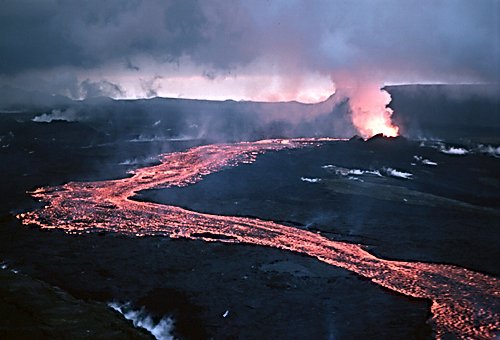
Effusive lava flow during a rift eruption at Krafla in 1984.
Phot by Michael Ryan, commons.wikimedia.org
Explosive eruption at Eyjafjallajökull.
Photo by Árni Friðriksson, commons.wikimedia.org.
Effusive eruptions
Effusive eruptions are represented by constant outpouring of lava onto the surface. This process is what slowly accreted Iceland. The lava flows come in all sizes and shapes and the individual flow type usually determines their form. The lava’s ability to flow is given by its viscosity, which in turn is dependent on the chemical composition and temperature of the erupting lava. After eruption onto and during movement along the surface, lava quickly loses heat, which has a significant influence on the lavas viscosity. It is therefore more convenient to use the chemical composition to divide the products of effusive eruptions into different categories. Three main categories are defined: mafic, intermediate and felsic. The former produces very fluid magmas that form thin flows that often cover a large area (low aspect-ratio) whereas the latter forms thick and stubby flows (high aspect-ratio).
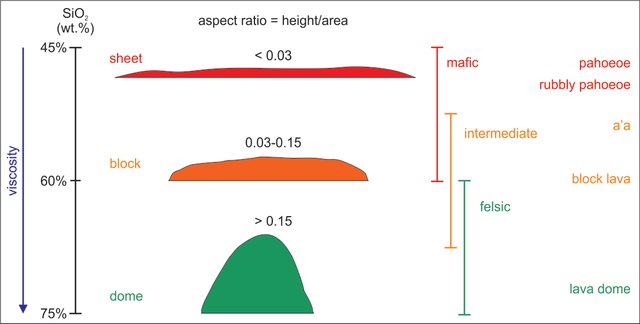
Geometric forms of lava flows and their relation to chemical composition and viscosity.
Drawn by author, inspired by Thordarson and Höskuldsson (2014).
Pahoehoe lavas (helluhraun in Icelandic) are formed during effusive eruptions of very fluid magmas on land. If the same lava type erupts under water, they form pillow lavas (bólstraberg in Icelandic). Both lava types are summarized under the term compound lavas, meaning they are composed of multiple round lobes with smooth outer surfaces.
On Iceland, pahoehoe lavas fields are composed of flows that vary in thickness between a few meters and a few hundred meters and can travel distances from 1 km up to 140 km. The flows are made up of lobes that range from finger sized, only a few cm wide strings, to sheet like lobes, several meters thick.
Pillow lava flows span similar areas but are, as the name suggest, made of larger, bulbous sack- or pillow-shaped loves. The lobes can be stretched along the flow direction to appear like large tubes.
In both instances, pahoehoe and pillow, the lava is transported from vents in the crust. Until it reaches the surface, the magma is only exposed to small temperature changes. This changes dramatically when the lava breaches the surface and pours out as lava. The abrupt decrease in temperature causes immediate solidification of the outermost layer of the lava flow. The continuously outpouring lava injects into the inner, still molten, part of the formed lobe, increasing the thickness and length of the lobe. Continuous cooling of the exterior of the lobe works against the extension pressure from the lava flow in the interior, until the lobe remains its form and a lava outbreak (usually at the front of the lobe) creates space for the lava to escape. Here a new lobe is formed and the described process begins anew. The complete process is known as lava inflation. This type of step wise lobe formation lets the lava travel significant distances beneath the initial solidification surface, without experiencing serious heat loss and therefore enabling it to form the extensive lava flow fields on Iceland.
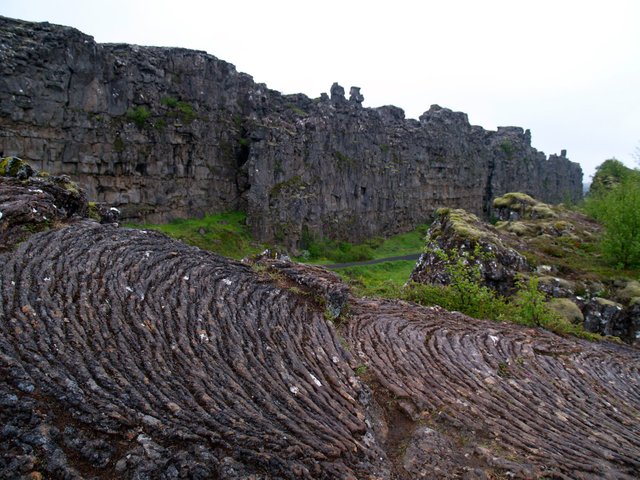
Helluhraun (pahoehoe lava) at Þingvellir, forming ropy lobes perpendicular to the flow direction.
Photo by Matt, flickr.com.

Formation of pahoehoe lava. Continuous lava flow seen in the back flows beneath the individual lobes towards the front and emerges at the base of the flow front.
nps.gov
Video by lavapix
More viscous mafic and intermediate magmas form a’a lavas (apalhraun in Icelandic) and are usually produced in mixed eruptions. They are usually thicker and shorter than volume equivalent pahoehoe flows. A’a flows have steep flow fronts and rough clinker surfaces. These rough surfaces are the result of constant tearing on the lava surface. The majority of lava movement in a’a flows occurs in broad open channels. Here lava speeds can be up to 70 kmh. The actual lava fronts move much slower (<2 kmh), because it fans out and slows down during this process. A slowly advancing a’a flow front becomes steeper and steeper, until it collapses and new lava overflows the broken down front, forming a new flow front and repeating the process. Viewed as a whole, an a’a flow consists of coherent lava in the center with irregular outlines that are surrounded by layers of clinker.
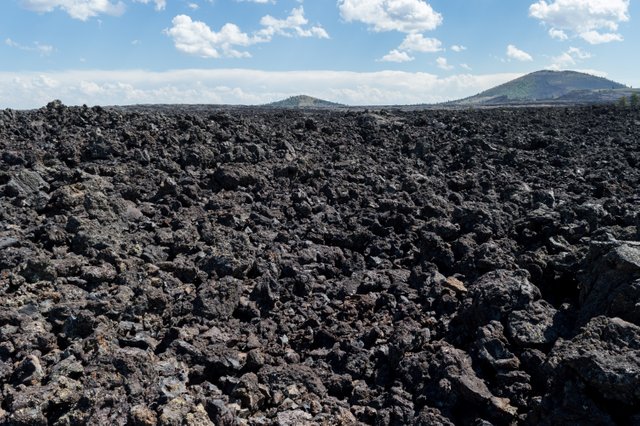
A'a lava flow field at the Craters of the Moon national Park (USA).
Photo by Supercarwaar, commons.wikimedia.org.
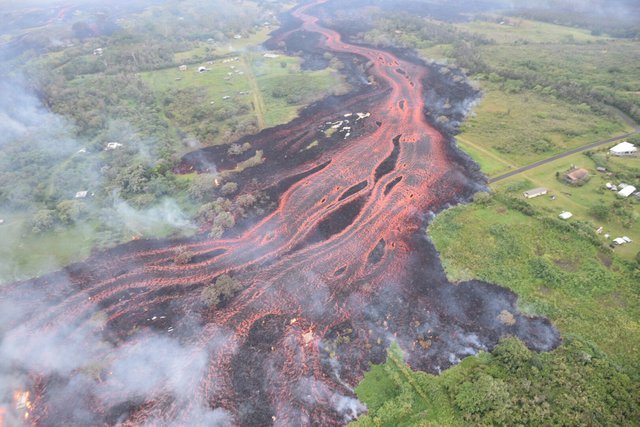
A'a lava flow at Kīlauea from May 19, 2018. Majority of lava movement occurs in open channels. Lava fronts move much slower because it fans out, forming little fingers.
usgs.gov.
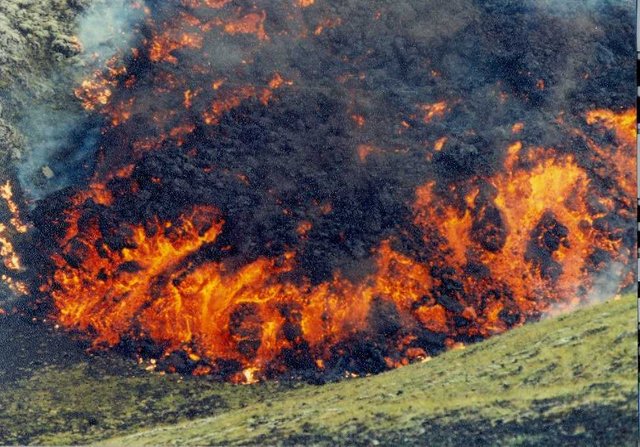
Apalhraun flow at Heimaey in 1973.
Photo by Necessary Evil, commons.wikimedia.org.
Video by Video by lavapix
Pahoehoe and a’a lavas often occur in the same flow field and transition from pahoehoe to a’a downstream is commonly observed. This transition results of viscosity changes caused by heat loss. Most lava flows on Iceland are a mixture of both lava types and exhibit flow tops (resembling a’a) and smooth basal surfaces. They do not directly fall into any of the two categories and are labelled as rubbly pahoehoe.
Rubbly pahoehoe at Hringvegur.
Photo by Hansueli Krapf, commons.wikimedia.org.
If the erupting magma is felsic in composition, they form black lavas and lava domes. They form very thick, up to 800 m, and short, less than 3 km, flows. The core of these lava flows consists of banded rhyolite, that is surrounded by obsidian (volcanic glass). The outermost shell of the flows is comprised of thick rubble made up of large blocks of broken lava fragments.
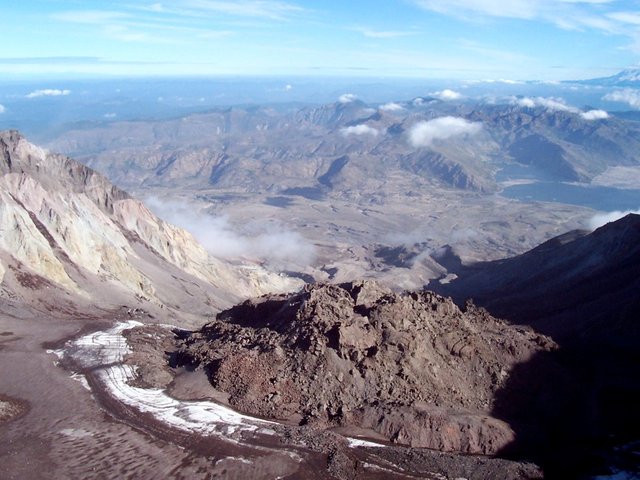
Mount St. Helens lava dome.
Photo by tjk, flickr.com.
Banded rhyolite.
Photo by Michael C. Rygel, commons.wikimedia.org.
Explosive eruptions
Explosive eruptions occur when magma in the upper part of a volcanic conduit gets ripped apart almost instantaneously by immense forces. If the explosion is the pure result of expanding magmatic gasses, that try to escape the magma, the eruption is labelled as magmatic. The explosive capability of a magma depends on its viscosity and the amount of gasses dissolved in it. Typically, felsic magmas form larger and more violent explosions because they have the highest viscosity and gas content. Both of these attributes are beneficial for gas build up. The higher a magmas viscosity the more resistance is exerted on the gas on its way to the surface. Mafic magmas, that are less viscous, usually have a low gas content that can easily escape, resulting in effusive eruptions styles to very weak explosive types.
If the explosion is caused by interaction between magma and meteoric water, be in groundwater or glacial meltwater, the resulting eruption is referred to as phreatomagmatic (hydromagmatic). The explosion is caused by nearly instantaneous transformation of the entering water into steam as soon as the water touches the magma. The power and size of the explosion is dependent on the ratio between water and magma. The ‘optimal’ water:magma ratio seems to lie at 0.3. At those conditions, phreatomagmatic eruptions can reach the size of any other magmatic explosive eruption.
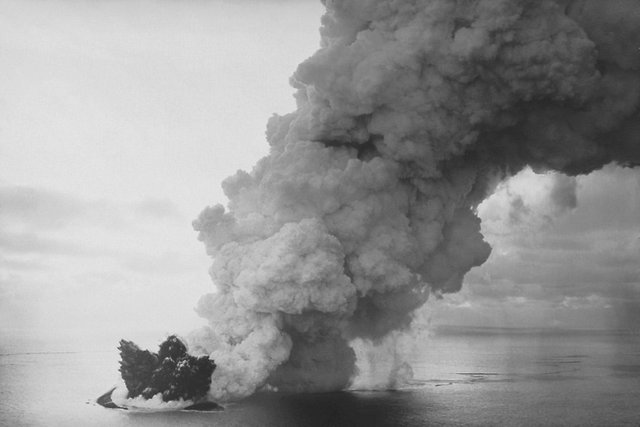
Phreatomagmatic eruption at Surtsey from 1963.
Photo by NOAA, commons.wikimedia.org.
The fragmented pieces of molten magma that are produced during explosive eruptions are, upon deposition, summarized under the term pyroclast or tephra. The volcanoclastic deposits are comprised of differently sized fragments and their rock name depends on the ratio of these particle sizes. For a detailed description feel free to look at my article on the classification of Pyroclastic Rocks. All of the pyroclastic fragments that we have seen in my previous posts can be observed in Iceland as well, like Pele’s tears and Pele’s hair. In Iceland, the latter has gotten its own name and is called nornahár (Witches hair).
Explosive eruptions form two types of volcanoclastic deposits. These are flow and fall deposits, depending of their mode of transportation. As the name suggests, flow deposits are formed by laterally moving currents of pyroclastic material. These currents are carried by liquid (usually water) that carries mixtures of tephra, fragmented lava and broken off, older pieces of country rock. The resulting rock type is often referred to as ignimbrite.
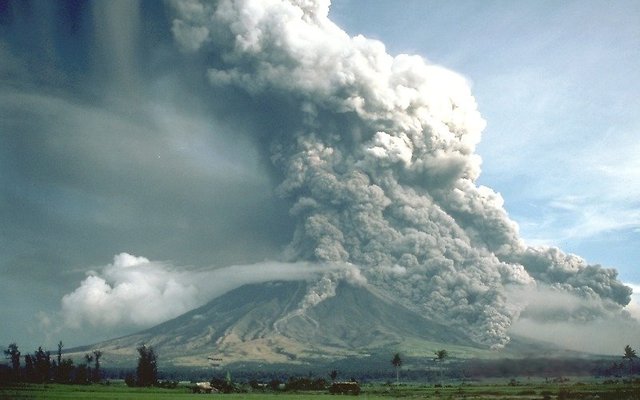
Pyroclastic flow at Mayon volcano, Philippines, 1984.
Photo by C.G. Newhall, volcanoes.usgs.gov.
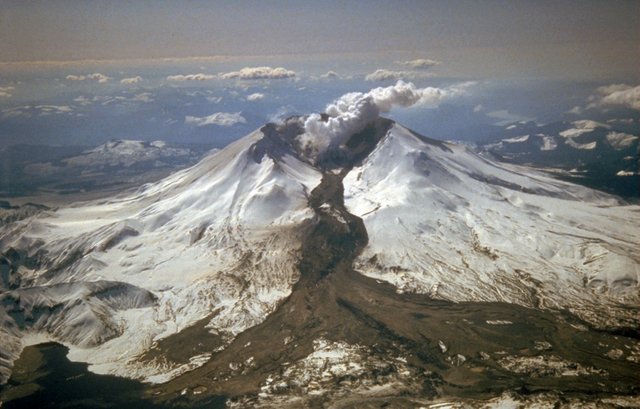
Lahar at Mount St. Helens. Lahars carry volcanoclastic material dispersed in water.
Phtot by Tom Casadevall, volcanoes.usgs.gov.
Fall deposits form thin uniform layers that often cover wide areas around and downwind from the volcanic vent. The thickness and individual grainsize of these fall deposits usually increases towards the vent. These type of deposits are extremely common in Iceland. This might explain why it was here that Sigurd Thorarinsson discovered their value for dating and by this founding the method of tephrachronology. Volcanic eruptions are instantaneous events. A widespread fall deposit therefore marks an exact moment in time and can be used to relatively date certain soil layers. Tephrachronology is nowadays a widely used technique in volcanology.
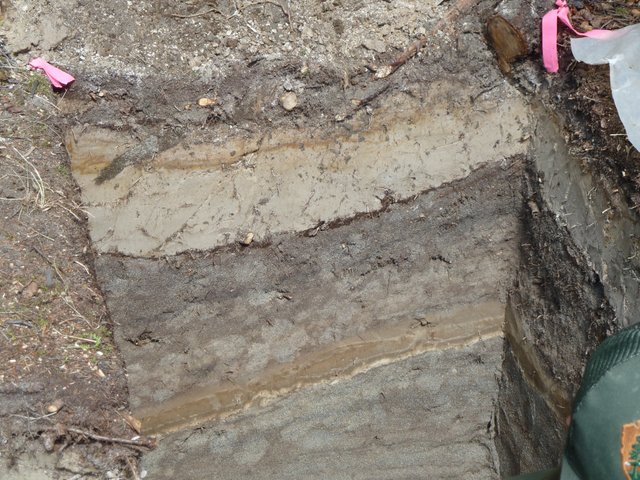
Soil Profile Showing 1912 ash layer. The thick light grey layer near the top of the photo is ash from the 1912 eruption. The brown layer toward the bottom of the profile is another ash layer from another volcano.
Photo by Katmai National Park and Preserve,flickr.com.
Previous posts
Geology of Iceland - Part 1: Introduction
Geology of Iceland - Part 2: The Iceland hotspot
Geology of Iceland - Part 3: an island being ripping apart
Geology of Iceland - Part 4: volcanic Systems
Geology of Iceland - Part 5: Magmas and Rocks
Geology of Iceland - Part 6: Volcano types
References
- Thorarinsson, S. (1981). Jardeldasvædi á nútíma (Volcanic areas of the Holocene). In: Náttúra Íslands, 2nd ed. Almenna bókafélagid, Reykjavík, 81–119.
- Thordarson, T. and Larsen, G. (2007). Volcanism in Iceland in historical time: volcano types, eruption styles and eruptive history. Journal of Geodynamics 43, 118-152.
- Thordarson, T. and Höskuldsson, Á. (2008). Postglacial volcanism in Iceland. Jökull 58, 197-228.
- Thordarson, T. and Höskuldsson, Á. (2014). Classic Geology in Europe 3: Iceland. Second Edition. Dunedin Academic Press Ltd, 256 pp.
https://en.wikipedia.org/wiki/Dense-rock_equivalent
https://en.wikipedia.org/wiki/Volcanic_Explosivity_Index
https://en.wikipedia.org/wiki/Pele%27s_hair
https://en.wikipedia.org/wiki/Tephrochronology

Resteemed because this is awesome (as always) and because of the tephrachronology which I hold dear.
Keep up the awesome posts! Thanks!
Thank you very much for the support :)
Thank you for posting awesome stuff!
Great post, really loved it. Loads of interesting facts i never knew about. Really funny that Iceland has such hot places :p
Very informative, very visual! Thanks for sharing! Thank you for educating me.
Hi @sooflauschig!
Your post was upvoted by utopian.io in cooperation with steemstem - supporting knowledge, innovation and technological advancement on the Steem Blockchain.
Contribute to Open Source with utopian.io
Learn how to contribute on our website and join the new open source economy.
Want to chat? Join the Utopian Community on Discord https://discord.gg/h52nFrV
You received a 80.0% upvote since you are a member of geopolis and wrote in the category of "geopolis".
To read more about us and what we do, click here.
https://steemit.com/geopolis/@geopolis/geopolis-the-community-for-global-sciences-update-4